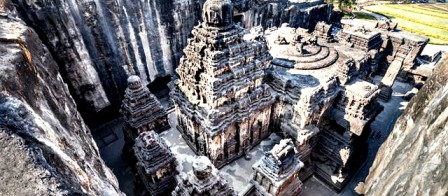Harsha (Harshavardhana)’s Reign – History Study Notes & Stuff
After the fall of the Gupta Empire, there was chaos on the political front in India. In the early 7th century BC, King Harshavardhana established a huge empire that extended from north & northwestern India till the Narmada in the South.
Sources for Study of Harshavardhana’s Reign:
- Harshacharita written by his court poet Banabhatta.
- Travelogues left by Chinese traveler Hiuen Tsang.
- Other important sources are the plays written by Harsha himself: Ratnavali, Priyadarshika, Nagananda.
- Other important source is Ratnavali, Priyadarshika and Nagananda which are drama written by Harsha himself.
- Sonpat inscription.
- Madhuben plate inscription.
- Banskhera inscription- has Harsha’s Autograph.
Pushyabhuti Dynasty:
- The founder of this dynasty was Pushyabhuti and they were feudatories of the Guptas and were known as Vardhanas.
- They became independent after the Hun invasion.
- Their capital was Thaneshwar in the north of Delhi.
- An important king of Vardhana Dynasty was Prabhakaravardhana.
- After his death, his elder son Rajyavardhan ascended to the throne of Thanesar. He was deceitfully murdered by the ruler of Bengal, Sasanka.
- Thereafter, 16 year old Harshavardhana ascend the throne of Thanesar in 606 AD.
Empire of Harsha – King Harshvardhana’s Empire
- Harsha ruled over a vast territory consisting of East Punjab, Uttar Pradesh, West Bengal, Bihar, Orissa.
- Nepal had accepted his overlordship.
- Harsha defeated the ruler of Kannauj and moved his capital to Kannauj.
- The most important battle fought by Harshavardhana was against the Chalukya ruler Pulakeshin II. Harshavardhana had ambitions to expand his empire beyond the Narmada.
- Pulakeshin's Aihole inscription mentions that Harsha was defeated.
Administration in Harshavardhana’s Reign:
Hiuen Tsang has described administration during Harsha’s reign in much detail, and it was similar to that of the Guptas.
- The administration was more decentralized and feudal during Harsha’s reign as compared to that of the Guptas.
- Harsha probably started the practice of giving land to officers in exchange for salary.
- The maintenance of public records was a feature of Harshavardhana's administration and records of good and bad events occurring during the period of time have been recorded in them.
- The archives were called Nilopitu and controlled by special authorities.
- At the time of Harsha, one-sixth of the crop yield was collected as land tax.
- Harshvardhan's army had four divisions - foot, chariot, horse and elephant, this was much more than the Mauryans.
- There was a provision of cruel punishment similar to the Mauryan period.
- Harsha had diplomatic relations with China.
Economy and Society during Harsha’s rule:
- There was four fold Varna system - Brahmins, kshatriya, Vaisya, and Sudra.
- The kings used to grant land to the Brahmins, the Kshatriyas were the ruling class, the Vaishyas were involved in trade and Sudas practiced agriculture. There were also many subcasts.
- Position of women: Women did not have privileges like swayamvara (option to choose husband), widow was not allowed to remarry, especially among upper castes. The sati and dowry practice became prevalent.
- Burial of dead: Dead were disposed either by cremation, water burial or exposure in the woods.
- During Harshavardhana's reign, trade and commerce declined, as indicated by the decrease in trade centers.
- This decline also affected handicraft and agriculture, increasing self-sufficiency in the village economy.
Developments in Art & Culture during Harshavardhana’s Reign:
The architecture during the Harsha period was mainly based on the Gupta style. Hiuen Tsang also spoke of an 8 feet high copper Buddha statue somewhere. He also spoke of a multistory monastery at Nalanda and a brick temple of Lakshmana, Sirpur in Chhattisgarh, is an example of architecture during the Harsha period.
Learning: Harsha was a great patron of learning and written himself three drama - Ratnavali, Nagananda and Priyadarshika. He also patronised Nalanda university. Harsha's biographer was Banabhatta, who wrote Harshacharita and Kadambari, other notable figures in Harshavardhana's court were Matanga Divakara and Bhartrihari (poet, grammatical and philosopher).
Religion during Harsha’s Reign:
Harshavardhan was a Shaiva follower within the beginning but gradually embraced Buddhism. He was a tolerant ruler. It is believed that Hiuen Tsang converted him to Mahayana . Harsha prohibited animal slaughter for food in his kingdom. He also erected various Stupa and established travellers’ resthouse everywhere his kingdom. He conducted a gathering of representatives of all religions once in every five years. Two of them are important:
Kannauj Assembly:
- It was presided over by Hiuen Tsang.
- There were 20 kings, 1000 scholars of Nalanda University, 3000 Brahmins - who attended this gathering in Kannauj.
- It continued till 23 days.
- Here, Hiuen Tsang explained and established the superiority of Mahayana values over others.
- However, violence erupted and an assassination attempt was made on Harsha's life.
Allahabad Assembly also known as Prayag Assembly:
- It was held for 75 days, where quinquennial distribution took place by the king to the people.
- Hiuen Tsang writes that Harsha actually gave everything from the royal treasury.
We hope that this short notes about Harsha (Harshavardhana)’s Reign is useful for your quick revision. If you want us to add any more details to this article, please do let us know in the comments below.











0 Comments